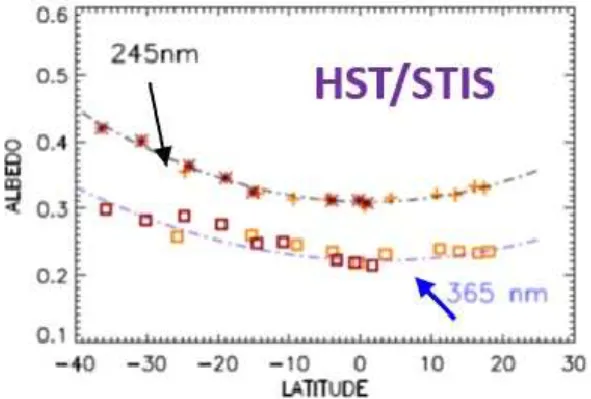HAL Id: insu-02298461
https://hal-insu.archives-ouvertes.fr/insu-02298461
Submitted on 26 Sep 2019
HAL is a multi-disciplinary open access
archive for the deposit and dissemination of sci-entific research documents, whether they are pub-lished or not. The documents may come from teaching and research institutions in France or abroad, or from public or private research centers.
L’archive ouverte pluridisciplinaire HAL, est destinée au dépôt et à la diffusion de documents scientifiques de niveau recherche, publiés ou non, émanant des établissements d’enseignement et de recherche français ou étrangers, des laboratoires publics ou privés.
Insights on Venus’Cloud Top Chemistry, Convective
Activity and Topographyfrom HST
Kandis-Lea Jessup, Emmanuel Marcq, Jean-Loup Bertaux, Franklin P. Mills,
Sanjay Limaye, Anthony Roman
To cite this version:
Kandis-Lea Jessup, Emmanuel Marcq, Jean-Loup Bertaux, Franklin P. Mills, Sanjay Limaye, et al.. Insights on Venus’Cloud Top Chemistry, Convective Activity and Topographyfrom HST. EPSC-DPS Joint Meeting 2019, Sep 2019, Geneva, Switzerland. pp.EPSC-DPS2019-672-2. �insu-02298461�
Insights on Venus’ Cloud Top Chemistry, Convective
Activity and Topography from HST
Kandis-Lea Jessup(1), Emmanuel Marcq(2), Jean-Loup Bertaux(2), Franklin P. Mills(3,4), Sanjay Limaye(5), Anthony Roman (6); Affiliations: (1) Southwest Research Institute, Boulder, USA; (2) LATMOS/IPSL, UVSQ Université Paris-Saclay, Sorbonne Université, CNRS, Guyancourt, France; (3) Space Science Institute, Boulder, USA; (4) Australian National University, Canberra, Australia; (5) University of Wisconsin, Madison, USA; (6) Space Telescope Science Institute
Abstract
Hubble Space Telescope (HST) spectra recording Venus’ cloud top properties over Aphrodite Terra (at 200-600 nm) and plains region located downwind of Aphrodite (at 200-300 nm) were obtained in 2010/2011[1-2]. Our analysis of these data [1-3] revealed the following key trends:
• Absorption at 245 nm that is not controlled by SO2 multiple
scattering.
• Parallels in the 245 and 365 nm cloud top albedo latitudinal variations which suggest that the same material and/or mechanism controls the distribution of the species responsible for absorption at those wavelengths. As the source of the 365 nm absorption remains unidentified, these results support that the unknown absorber either has more than one source [e.g., 4-6] and/or it has a continuum extending shortward of 300 nm [7-8]
• Consistent detection of the minimum albedo (at 245 or 365 nm) at the equator, and increased brightness with increasing latitude (Fig 1); which is consistent with Hadley cell circulation of the absorbing species [9].
Figure 1: (a) Comparison of the 245 and 365 nm albedo latitude variations observed over Aphrodite
by HST/STIS in 2011
• Terrain dependent local solar time (LST) darkening was observed at 245 nm, such that the albedo darkened by 20% over the plains between 10 and 11 hr, while over Aphrodite only limited (~0-10%) darkening was observed between 10 and 11 hr. The onset of the LST darkening correlates directly with the onset of previously observed and well documented subsolar convective activity at Venus’ cloud tops [10-12] which occurs in a shallow mixing zone [13].
• The peak SO2 abundance over
Aphrodite was 10-25x lower than observed over the plains 30 days prior, suggesting that the large-scale mixing via the Hadley cell circulation above Aphrodite was
EPSC Abstracts
Vol. 13, EPSC-DPS2019-672-2, 2019 EPSC-DPS Joint Meeting 2019
c
significantly lower than the plains on the dates of the HST observations. Additionally, reversal of the SO2
latitude distribution from decreasing with increasing latitude, to increasing with increasing latitude reveals the vertical mixing rates above Aphrodite were low enough to allow photochemical depletion of the low-latitude SO2 gas abundance
within a 5-day period. [1,9].
• There was no sensitivity of the cloud top albedo latitude distribution gradient to the observed SO2 gas
latitude distribution gradient— implying the unknown absorber abundance is not directly linked to the SO2 photochemical process.
1. Conclusions & Recommendations
Based on the HST observed LST and latitude albedo variations we conclude that topography impacts the vertical distribution of Venus’ unidentified absorber(s) through both large and small-scale mixing processes. As this (these) species have a direct impact on Venus’ radiative balance, climate and cloud super-rotation, we strongly advocate for future observations that can uniquely and contemporaneously characterize Venus’ cloud top albedo and chemistry relative to Venus’ underlying surface topography and zonal cloud motions.
2. Acknowledgements
This research was funded through the NASA Venus Climate Orbiter Participating Scientist program, NASA Grant NNX16AK82G (Jessup); NNX16AC79G (Limaye). F.P. Mills acknowledges partial support under NASA Grant NNX12AI32G and NNX16AN03G to Space Science Institute. E.Marcq acknowledges support from CNES and from the Programme National de Planétologie (PNP) of CNRS/INSU.
References
[1] Jessup, K-L., Marcq, E., Mills, F, Limaye, S, Bertaux, J-L, Roman, A, Icarus, submitted, 2019;
[2] Jessup, K-L., Marcq, E., & Mills, F, Mahieux, A, Limaye, S, Wilson, C, Allen, M, Bertaux, J-L, Markiewicz, W, Roman, T, Vandaele, A-C, Wilquet, V, Yung, Y. 2015 Icarus, 258, 309-336;
[3] Jessup et al. 2017 Parameterizing Venus' aerosol
particle size distribution (Fall AGU), New Orleans, LA,
USA;
[4] Bertuax et al. 1996 Geophys Res 101, 2709–12746; [5] Jessup et al. 2017 Motivations for a Detailed In-Situ
Investigation of Venus' UV Absorber, (VEXAG 15), Laurel
MD, USA;
[6] Limaye S. Mogul R. & Smith David J., Ansari Arif H., Słowik Grzegorz P. Astrobiology 2018. doi/10.1089/ast.2017.1783;
[7] Krasnopolsky 2012 Icarus, 218, 230-246.;
[8] Marcq, E., D. Belyaev, F. Montmessin, A. Fedorova, J.-L. Bertaux, A. C. Vandaele, and E. Neefs Icarus, 211, 58– 692011;
[9] Marcq E. Bertaux, J-L & Montmessin, F, Belyaev, D,
Geoscience 6, 25–28 2013
[10] Rossow Del Genio A. D. & Limaye S. S., Travis L. D., Stone P. H, J Geophys Res 85(A13):8107–8128, 1980. [11] Limaye, S.S., Icarus, 73, 212-226,1988.
[12] Markiwiecz W. J., Titov, D. V. & Limaye, S. S., Keller, H. U., Ignatiev, N., Jaumann, R., Thomas, N., Michalik, H., Moissl, R., Russo, P.. 2007 Nature, 450, 633–636, 2007.
[13] Baker R. D., Schubert, G. & Jones, P. W, Geophys.
